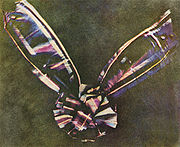
Thomas Sutton (photographer)
Encyclopedia

Life
Thomas Sutton went to school in Newington ButtsNewington Butts
Newington Butts is a former village, now an area of the London Borough of Southwark, that gives its name to a segment of the A3 road running south-west from the Elephant and Castle junction...
and studied architecture for four years before studying at Caius College, Cambridge graduating in 1846 as the twenty-seventh wrangler. He opened a photographic studio in Jersey
Jersey
Jersey, officially the Bailiwick of Jersey is a British Crown Dependency off the coast of Normandy, France. As well as the island of Jersey itself, the bailiwick includes two groups of small islands that are no longer permanently inhabited, the Minquiers and Écréhous, and the Pierres de Lecq and...
the following year under the patronage of Prince Albert
Prince Albert
Prince Albert was the husband and consort of Queen Victoria.Prince Albert may also refer to:-Royalty:*Prince Albert Edward or Edward VII of the United Kingdom , son of Albert and Victoria...
. In 1855 he set up a photographic company in Jersey with business partner Louis Désiré Blanquart-Evrard
Louis Désiré Blanquart-Evrard
Louis Désiré Blanquart-Evrard was a French cloth merchant by trade, but in the 1840s became a student of photography. He studied the Calotype process, and in 1847 became the first person to publish the process in France...
that produced prints from calotype
Calotype
Calotype or talbotype is an early photographic process introduced in 1841 by William Henry Fox Talbot, using paper coated with silver iodide. The term calotype comes from the Greek for 'beautiful', and for 'impression'....
negatives. The following year, Sutton and Blanquart-Evrard founded the journal "Photographic Notes", which Sutton edited for eleven years. A prolific author, Sutton wrote a number of books on the subject of photography, including the Dictionary of Photography in 1858.
In 1859, Sutton developed the earliest panoramic camera with a wide-angle lens. The lens consisted of a glass sphere filled with water, which projected an image onto a curved plate. The camera was capable of capturing an image in a 120 degree arc. Another photographic development was the first Single Lens Reflex camera, in 1861. He was also the photographer for James Clerk Maxwell's
James Clerk Maxwell
James Clerk Maxwell of Glenlair was a Scottish physicist and mathematician. His most prominent achievement was formulating classical electromagnetic theory. This united all previously unrelated observations, experiments and equations of electricity, magnetism and optics into a consistent theory...
early experiments in color photography and in 1861 took the world's first permanent color photograph
Color photography
Color photography is photography that uses media capable of representing colors, which are traditionally produced chemically during the photographic processing phase...
of a Tartan ribbon. Maxwell directed Sutton to take three photographs of the ribbon, through a red, green, and blue filter, respectively. The plates were developed and projected on a screen by three projectors, each with the same color filter used to take its photograph. When brought together in focus, a full-color image was formed. He also worked on the development of dry photographic plates.

